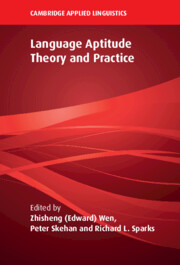106 results
Assessment of ring-tailed lemur Lemur catta populations in south-western Madagascar
-
- Article
-
- You have access
- Open access
- HTML
- Export citation
Part I - Revisiting and Refining Aptitude Tests
-
- Book:
- Language Aptitude Theory and Practice
- Published online:
- 27 May 2023
- Print publication:
- 27 April 2023, pp 23-116
-
- Chapter
- Export citation
Copyright page
-
- Book:
- Language Aptitude Theory and Practice
- Published online:
- 27 May 2023
- Print publication:
- 27 April 2023, pp vi-vi
-
- Chapter
- Export citation
1 - Language Aptitude Research
-
-
- Book:
- Language Aptitude Theory and Practice
- Published online:
- 27 May 2023
- Print publication:
- 27 April 2023, pp 1-22
-
- Chapter
- Export citation
Part II - Aptitude Testing of Diverse Groups
-
- Book:
- Language Aptitude Theory and Practice
- Published online:
- 27 May 2023
- Print publication:
- 27 April 2023, pp 117-246
-
- Chapter
- Export citation
Preface and Acknowledgments
-
- Book:
- Language Aptitude Theory and Practice
- Published online:
- 27 May 2023
- Print publication:
- 27 April 2023, pp xxvii-xxviii
-
- Chapter
- Export citation
Index
-
- Book:
- Language Aptitude Theory and Practice
- Published online:
- 27 May 2023
- Print publication:
- 27 April 2023, pp 491-494
-
- Chapter
- Export citation

Language Aptitude Theory and Practice
-
- Published online:
- 27 May 2023
- Print publication:
- 27 April 2023
Part IV - Aptitude–Treatment Interaction (ATI)
-
- Book:
- Language Aptitude Theory and Practice
- Published online:
- 27 May 2023
- Print publication:
- 27 April 2023, pp 355-440
-
- Chapter
- Export citation
Part III - Innovative Perspectives and Paradigms
-
- Book:
- Language Aptitude Theory and Practice
- Published online:
- 27 May 2023
- Print publication:
- 27 April 2023, pp 247-354
-
- Chapter
- Export citation
Contents
-
- Book:
- Language Aptitude Theory and Practice
- Published online:
- 27 May 2023
- Print publication:
- 27 April 2023, pp vii-ix
-
- Chapter
- Export citation
Editors and Contributors
-
- Book:
- Language Aptitude Theory and Practice
- Published online:
- 27 May 2023
- Print publication:
- 27 April 2023, pp xvi-xxvi
-
- Chapter
- Export citation
Part V - Final Commentaries
-
- Book:
- Language Aptitude Theory and Practice
- Published online:
- 27 May 2023
- Print publication:
- 27 April 2023, pp 441-490
-
- Chapter
- Export citation
Tables
-
- Book:
- Language Aptitude Theory and Practice
- Published online:
- 27 May 2023
- Print publication:
- 27 April 2023, pp xiii-xv
-
- Chapter
- Export citation
Figures
-
- Book:
- Language Aptitude Theory and Practice
- Published online:
- 27 May 2023
- Print publication:
- 27 April 2023, pp x-xii
-
- Chapter
- Export citation
259 Proton pump inhibitor use is not significantly associated with severe COVID-19 related outcomes after extensive covariate adjustment
-
- Journal:
- Journal of Clinical and Translational Science / Volume 6 / Issue s1 / April 2022
- Published online by Cambridge University Press:
- 19 April 2022, p. 43
-
- Article
-
- You have access
- Open access
- Export citation
Systematic and other reviews: criteria and complexities
-
- Journal:
- The Journal of Laryngology & Otology / Volume 135 / Issue 7 / July 2021
- Published online by Cambridge University Press:
- 13 July 2021, pp. 565-567
- Print publication:
- July 2021
-
- Article
-
- You have access
- HTML
- Export citation
A history of high-power laser research and development in the United Kingdom
- Part of
-
- Journal:
- High Power Laser Science and Engineering / Volume 9 / 2021
- Published online by Cambridge University Press:
- 27 April 2021, e18
-
- Article
-
- You have access
- Open access
- HTML
- Export citation
Correlating Microstructure to in situ Micromechanical Behaviour and Toughening Strategies in Biological Materials
-
- Journal:
- Microscopy and Microanalysis / Volume 25 / Issue S2 / August 2019
- Published online by Cambridge University Press:
- 05 August 2019, pp. 372-373
- Print publication:
- August 2019
-
- Article
-
- You have access
- Export citation
Chemical, Biological, Radiological, Nuclear, and Explosive (CBRNE) Science and the CBRNE Science Medical Operations Science Support Expert (CMOSSE)
-
- Journal:
- Disaster Medicine and Public Health Preparedness / Volume 13 / Issue 5-6 / December 2019
- Published online by Cambridge University Press:
- 17 June 2019, pp. 995-1010
-
- Article
- Export citation

